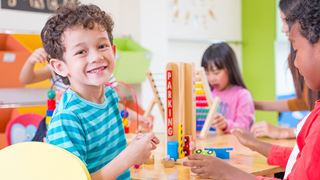Education and Immigration: How to Overcome Language Barriers in the Classroom
In the past decade, the number of children who have English as an additional language (EAL) being placed in schools within the UK has increased noticeably. This is in line with changes to school populations and the number of pupils being enrolled in education.
According to school population statistics, 19% of children in UK state schools are EAL learners. That means that almost one-fifth of the pupils in classrooms around the country are being taught in a different language.
The integration of children from other countries into the UK school system can pose a range of challenges for teaching staff, including language barriers. In this article, we take a look at the many ways schools across the UK are learning to deal with language barriers and cultural differences and how education professionals can approach this in their classrooms.
What Are Language Barriers?
Language barriers occur when people that need to communicate with one another don’t have a common language that they can comfortably use to talk. They usually appear when one or more people aren’t speaking their native language, or are trying to communicate in a language they don’t understand.
In cases of immigrants in education, children that have travelled to the UK from other countries may not have a good grasp, or any grasp, of the language. This makes it difficult for them to understand what is happening when placed in an English-speaking school, especially if no other student or teacher speaks their language.
How Do Language Barriers Affect Immigrants?
In a general sense, language barriers can make it very difficult for people who have immigrated to the UK to adjust to their new life and feel connected to their new community. Moving to a new country is always a disorientating experience, and being unable to understand the language all around you can make it even more overwhelming.
Without a confident grasp of English, essential tasks can be very difficult, such as going to the shops, accessing healthcare and finding a job. Not only can language barriers increase the time it takes for immigrants to settle into a new location, but they can create a sense of loneliness and isolation which may impact wellbeing.
While the UK prides itself on being a diverse and multicultural country, language barriers can sometimes prevent children from learning and getting the most out of their education. It can also make it much harder for children to make new friends at school and integrate with their peers, which again can lead to loneliness, isolation and a lack of enjoyment at school.
How to Overcome Language Barriers in the Classroom
Teachers working in classes with immigrant students may have to deal with language barriers that impact their ability to teach. Whilst the best way to learn any language is to be immersed in it, you cannot just leave a student to try and pick up a new language by themselves.
In some classrooms, teachers are having to cope with pupils that speak as many as 20 different languages, with various cultures coming together to study. Although classrooms like this are a relatively new challenge for most schools, others have more experience working with EAL children, which has allowed them to develop tried and tested approaches.
Here are some of the best strategies for how to overcome language barriers with children.
Name Pronunciation
Learning a new student’s name and being able to pronounce it correctly is incredibly important when helping an EAL child settle into a class where they don’t speak the language. It’s easy for students facing language barrier problems to feel isolated or like an outsider, but being able to pronounce and spell their name correctly can help to bridge this initial gap and make communication feel a little more familiar.
When possible, teachers should also make the effort to ensure that the rest of the students in the class can also pronounce the new child’s name correctly. You might also want to teach the class a basic greeting in the new student’s language, which again can help to bridge the language barrier gap.
Intervention Classes
Until EAL students understand and can speak basic English, trying to integrate them into a class will be difficult. This is why many schools accepting students with no English place them into intervention classes. Here, specially trained teachers focus on teaching the children practical, everyday English.
Teachers in these types of classes will put a strong emphasis on speaking, listening and vocabulary, and children are paired with each other to help them check their understanding. There will also be a focus on pronunciation and writing.
Buddy System
A great way to support children learning English and working through language barrier problems is to pair up new students with a ‘buddy’ in their class. This can really help children to settle in faster, make them feel more supported and let them learn from a peer as well as from adults.
It’s easier to use a buddy system when an immigrant child has a basic understanding of English, especially if students are quite young, as it can be overwhelming for the other student if they can’t communicate with a new classmate at all. However, children are very resilient and also benefit from connecting through play, which is a great way to facilitate learning a language in a new environment.
For older students learning English, having a class ‘buddy’ also gives them someone they can ask questions to and help explain any cultural differences and contexts. Learning from a peer often seems less daunting than learning from a teacher when a child is older, which is another reason why this approach is useful.
Group Work
Getting EAL students to engage with learning is one of the things that will help them to pick up the new language faster, but is also one of the most challenging things to encourage. Group work is an excellent tool to increase engagement, and should be used as a technique for overcoming language barriers in education.
Working in a group allows EAL students to practice conversing with their peers in front of a smaller audience, which reduces the pressure and potential embarrassment and may help them to open up more. It also can make it easier for them to follow the conversation, as there will be fewer people speaking to each other in a quieter setting.
Placing an EAL student in a group for a project or a task can also help them to connect with their peers and give them a sense of accomplishment when the group completes a task, which may be lacking if they’re finding independent work more difficult.
Label Classroom Objects
It can be frustrating for an EAL student to be unable to communicate or identify the things around them in a new language, which is why labelling classroom objects in both languages can be incredibly useful. This makes it easier for students to ask for what they need or explain what they’re looking at, which can reduce frustration and speed up understanding.
Having labelled objects in their surroundings all the time will also make it easier for immigrant children to increase their English vocabulary. Exposure to the same words over and over will help them to learn and feel more familiar with the language and help them passively improve their skills.
Multi-Strategy Approach
One thing that is certain when overcoming language barriers is that numerous approaches are better than just one. Instead of just speaking to students and expecting them to listen, both teachers and EAL students benefit from the use of blended learning that combines multiple approaches.
This means incorporating visuals, student discussion, translated key words, sentence and writing frames, interactive learning games and so on, into lessons. EAL students will be a mix of visual, kinesthetic and auditory learners, so it's crucial that education professionals engage with students in each of these ways.
First Languages
When a student is learning to navigate language barrier problems, it’s important that you let them converse in their first language and allow them to use it to communicate when English becomes too difficult. This is especially important if you have other students or staff in the school who can speak the language as well, as it helps the EAL student to feel less alone and ensures they can be understood.
You should encourage the use of English to help build confidence and develop their language skills, but also use the student’s first language to help them understand things like sentence structure or allow them to complete tasks at a more complex level. You don’t want to encourage reliance on translation, but you shouldn’t discourage the use of a first language altogether.
Involve Parents
Many EAL and immigrant students being introduced to schools in England come from families that are either new to the country or speak little to no English. Sometimes, a child’s parents may be able to speak English, yet choose to converse in their first language at home. This is why schools need to engage with parents and encourage them to help their children with English outside of the classroom.
In some areas of the UK, schools are introducing outside-of-standard learning hours, which include time for families to come in and understand how the education system works. While this can be challenging, it is often enriching for all parties.
Asking parents for advice and input can also prove to be useful and helps to build strong relationships between parents, teachers and students.
FAQs
What causes language barriers?
Language barriers are caused when two or more people don’t have a common language with which they can communicate. This usually happens when someone comes to a new country and hasn’t learned the native language, which is sometimes the case with immigrants to the UK and particularly impacts children or the elderly.
How can language barriers affect communication?
Language barriers can affect communication because they stop everyone involved from being able to fully understand one another. Even if some or all people involved in a conversation have a basic grasp of the same language, words or intentions can be misinterpreted, or someone might not understand everything that has been said, which impacts proper understanding and can lead to mistakes or disagreements.
How can language barriers be overcome?
The best way to overcome language barriers is for everyone involved to have a good grasp of the same language, which usually requires one or more people to learn or improve their language skills. Cultural context and understanding are just as important as learning new words and meanings, as the context of conversations often contributes to them as much as what is actually said.
Summary
More and more teaching staff are starting to see EAL students appearing in their classrooms, and whilst many of these may have no issues with speaking and learning in English, some of them may be new to the country or simply require additional support in order to understand what’s being said. It can be challenging to begin with, but by combining a range of approaches and immersing the student in the new language without overwhelming them, you’ll start to see positive results in no time.
If you’re an educational professional looking for more ways to help make your classroom a safe and inclusive place for all students to learn, we offer a wide range of online safeguarding courses that will help develop your existing knowledge.


















/safer-recruitment.jpg?mw=320&hash=A2BB5E144C89C295EC10C63680F69F39C4C3E566)









/e-safety-.jpg?mw=320&hash=A9FCF6B70F32AD3EA74633373FF0213B000F75FF)



























